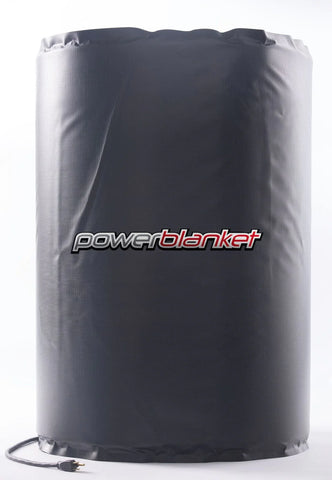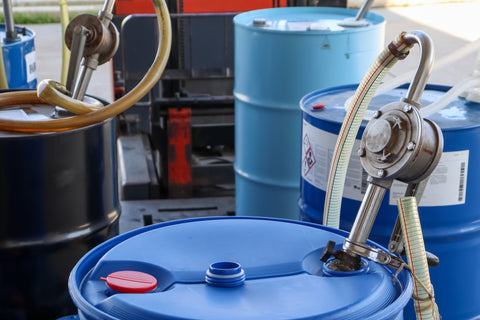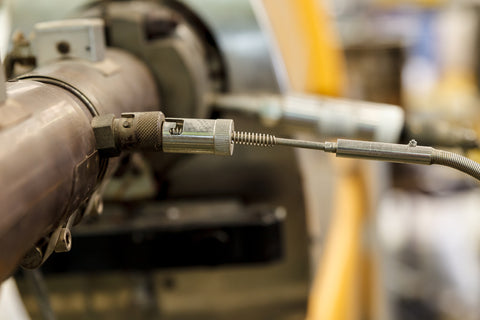The Key to Vibrant Indigo Dyeing: Mastering Temperature Control
Indigo dyeing is a rich and fascinating process, deeply rooted in history and tradition, yet still highly relevant in modern textile production. Whether you're working with natural indigo dye extracted from the Indigofera tinctoria plant or synthetic indigo, the dyeing process hinges on one crucial factor: temperature control. Achieving the desired deep blue tint and ensuring that your dyed fabric has consistent color saturation depends on maintaining the correct temperatures throughout the dyeing process.
Proper heating is essential to avoid issues like excess dye settling at the bottom of the vat or the dye becoming too viscous to penetrate the fabric properly. A well-regulated temperature ensures that the dye stays in its reduced solution form, maintaining its color potential while adhering evenly to the fibers. This is where effective tools, such as drum and barrel heaters, come into play. Designed specifically for the demands of the indigo dyeing process, these heaters maintain the necessary warmth to keep the dye bath at the optimal temperature, making them indispensable for both large-scale manufacturers and independent artisans alike.
In this article, we’ll dive deep into the science and artistry behind the indigo dyeing process, exploring the significance of temperature control, the chemical interactions at play, and the best tools for achieving consistent, high-quality results. Whether you’re looking to enhance your dyeing techniques or better understand the role of temperature in achieving those vivid indigo hues, this guide will provide the insights you need.
From Plant to Pigment: The Steps in Crafting an Indigo Dye Vat

The process of turning indigo flowers into indigo dye is both an art and a science. It has been used for centuries to create beautiful, deep blue fabrics, from ancient garments to modern textiles. Understanding the fundamentals of this process helps us appreciate the complexity behind those stunning shades of indigo.
Indigo dye, whether sourced from natural or synthetic indigo, is unique among dyes because it requires a reduction and oxidation process to produce its characteristic color. Unlike many other natural dyes, indigo does not require a mordant to fix it to the fabric. Instead, it uses a chemical reaction that begins with preparing a vat.
How Do You Process Indigo for Dyeing?
To start dyeing natural indigo, you must first prepare the indigo itself. This involves extracting indigo pigment from either Indigofera tinctoria leaves for natural indigo or using synthetic sources for commercial purposes. The raw indigo must then be transformed into a form that can bond to fibers — this is done by creating an indigo vat.
Steps to Prepare Indigo for Dyeing:

-
Harvesting and Extracting Indigo Pigment: If using natural indigo, the leaves of the Indigofera tinctoria plant are harvested and soaked in water to ferment. This process releases the indigo pigment in a reduced, water-soluble form.
-
Fermentation and Reduction: The fermented liquid is combined with a reducing agent, such as ferrous sulfate or fructose, to remove excess oxygen, converting the indigo into its leuco indigo state. This reduced solution is a greenish-yellow color, indicating it is ready to dye.
-
Creating the Indigo: To make the dye bath, indigo powder is mixed with other ingredients like calcium hydroxide (commonly known as lime) and a reducing agent. This mixture is then kept warm to maintain the dye in its reduced, soluble form.
By controlling the temperature and ingredients in your indigo vat, you ensure that the dye remains effective and ready to produce a rich, vibrant color on the fabric.
What is the Chemical Process of Indigo Dye?
The chemical process behind indigo dyeing involves two main phases: reduction and oxidation. When indigo is reduced, it becomes soluble in water and bonds with the fabric's fibers. Once the fabric is removed from the dye bath and exposed to air, oxidation occurs, and the dye transforms into its insoluble blue form, permanently coloring the fabric.
-
Reduction Phase: During reduction, the indigo pigment is converted into a colorless form that dissolves in water. This process often uses a reducing agent like ferrous sulfate, fructose, or other chemicals to remove oxygen from the vat.
-
Oxidation Phase: Once the fabric is dyed and removed from the dye bath, it is exposed to oxygen. The indigo oxidizes back into its original blue form, becoming insoluble and binding tightly to the fabric's fibers.
Maintaining the right temperature in your indigo vat is critical to this chemical process. If it is too cold, the dye may not be reduced properly, making it unstable. Too hot, and the indigo can break down, losing its color potency. This is why temperature control tools are essential — they ensure the indigo vat stays within the optimal temperature range, allowing the chemical reactions to proceed correctly and consistently.

The Role of Temperature in Indigo Dyeing
Temperature plays a pivotal role in indigo dyeing, affecting both the dye bath's stability and the resulting color of the dyed fabric. Controlling the temperature of the dye bath is crucial for a successful dyeing outcome.
Why is Temperature Control Important?
-
Consistency in Color Saturation: The right temperature helps achieve a uniform color throughout the fabric. If the dye bath is too cold, the indigo pigment may not fully reduce, leading to uneven dyeing and patchy colors. On the other hand, if the dye bath is too hot, the dye might degrade, resulting in faded or inconsistent hues.
-
Preventing Dye from Freezing or Becoming Viscous: Indigo dye can become too thick or even solidify if the temperature drops too low, making it challenging to dye evenly. Maintaining a warm bath of dye ensures that the natural dye remains fluid and easy to work with, allowing it to penetrate the fibers evenly.
-
Optimal Chemical Reactivity: The chemical reactions required for indigo dyeing depend heavily on temperature. Reduction requires warm water, while oxidation occurs when the fabric is exposed to air. Proper heating ensures these reactions happen at the right pace, giving you control over the depth and consistency of the color.
What Temperature Do You Dye Indigo?
The ideal temperature for an indigo bath is generally between 50-60°C (122-140°F), depending on the type of fabric and the concentration of the dye. Maintaining this temperature range ensures that the dye stays in its reduced state without breaking down.
Keeping the indigo vat within this temperature range prevents the dye from becoming too thick, ensures proper reduction, and allows for smooth, even dyeing.
Tools for Effective Temperature Control in Indigo Dyeing
Maintaining the proper temperature throughout the dye bath is essential to achieving the best results in dyeing indigo. The right tools can make all the difference, ensuring the indigo dye remains stable, consistent, and effective. Here, we’ll explore some of the most effective tools for controlling temperature in indigo vats.
Highlighted Product: Heating Elements for Barrels and Drums
For example, a heater like this is designed to provide consistent and controlled heating for large volumes of dye, such as those in 30 or 55-gallon drums. This product is ideal for maintaining the necessary temperature in indigo vats, ensuring that the dye remains in its reduced state and is ready for use. Let’s look at why this tool is essential for anyone involved.
-
Consistent Heat Distribution: Evenly distributes heat throughout the indigo vat, preventing cold spots where the dye might thicken or settle. This uniform heating is crucial for keeping the dye bath at the right temperature, whether using hot water or warm water or maintaining a stable heated environment.
-
Easy Temperature Adjustments: With adjustable temperature settings, you can easily control the heat levels according to your specific requirements, whether you’re working with a natural indigo dye or a synthetic indigo dye bath. This flexibility helps maintain the ideal conditions for reducing the dye and achieving the desired shades, from lighter blue tints to deeper, dark blue hues.
How to Choose the Right Heating Equipment for Dyeing?
When selecting heating equipment for indigo dyeing, consider the following factors to ensure you maintain the ideal temperature throughout your dyeing process:
-
Volume of Dye: The amount of indigo dye you’re working with will determine the size and capacity of the heating equipment you need. Larger vats or drums will require more powerful heaters to maintain a consistent temperature.
-
Type of Fabric: Different fabrics, such as protein fibers like wool yarn or silk scarves, require specific temperatures for optimal dyeing. Natural fibers often need gentler heat compared to synthetic materials.
-
Required Temperature Range: Depending on whether you’re using a ferrous vat, henna vats, or a fructose vat, the ideal temperature range may vary. Make sure the heating equipment can reach and maintain these temperatures consistently.
-
Durability and Safety: Choose heating tools designed for safe and continuous use in dyeing environments. Equipment with safety features, such as thermal cutoffs or automatic shutoff functions, can help prevent overheating or damage to the dye bath.
Best Practices for Maintaining Temperature During Indigo Dyeing
Keeping the temperature stable during the processing indigo is key to achieving vibrant and consistent colors. Here are some best practices to ensure your dye bath stays within the optimal temperature range:
-
Monitor the Temperature Regularly: Use a thermometer to check the temperature of your indigo vat frequently. This helps ensure it stays within the ideal range and allows for quick adjustments if the temperature fluctuates.
-
Use Proper Heating Tools: Invest in reliable heating equipment to maintain consistent heat distribution. This is especially important for large dye baths or when working with multiple indigo vats.
-
Preheat the Water: Begin with hot tap water or boiling water to speed up the process of creating a warm dye bath. This helps achieve the required temperature more quickly and reduces the time needed to heat the indigo vat.
-
Insulate Your Vats: Insulating the dye vat with blankets or other insulating materials can help retain heat, reducing the need for constant heating and saving energy. A tight lid can also help prevent heat loss and keep the indigo dye at a stable temperature.
-
Adjust for Environmental Conditions: Consider factors like ambient temperature and humidity, which can affect the dye bath's temperature. In cooler conditions, you may need to increase the heat slightly or insulate your vat more effectively to maintain the correct temperature.
How Long Does It Take to Dye Indigo?
The time required for dyeing with indigo can vary depending on the fabric type, the dye concentration, and the desired depth of color. Typically, the dyeing process involves dipping the fabric into the dye bath multiple times to achieve a rich and even color.
-
Typical Timeframes: For cotton, linen, or other cellulose fibers, each dip may last between 2 to 10 minutes, depending on the desired shade. Protein fibers, like wool yarn or silk scarves, might require longer dips to ensure the dye fully penetrates the fibers.
-
Influence of Temperature: Maintaining the correct temperature in the indigo vat can help reduce dyeing time, as the dye remains in its optimal reduced state, ready to bond with the fibers. Cooler dye baths may require longer immersion times to achieve the same color intensity.
You can create a consistent and vibrant finish on any dyed fabric by carefully managing the time and temperature during the dyeing process.
How to Make Indigo Dye Darker?
Achieving a deeper, more intense indigo color often requires special techniques to enhance the dye's penetration and build up multiple layers of color on the fabric.
-
Multiple Dips: Dipping the fabric multiple times in the dye bath is the most effective way to darken indigo dye. Each dip adds another layer of color, gradually building up to a rich, dark blue shade.
-
Adjust Dye Concentration: Increasing the concentration of indigo pigment in the vat can also result in a darker color. However, this requires careful management to avoid wasting dye or creating excess dye sediment.
-
Maintain Optimal Temperature: Keeping the dye bath at the right temperature helps maintain the indigo in its reduced state, making it easier to achieve a deeper color with fewer dips.
By following these techniques, you can enhance the depth and richness of your indigo-dyed fabrics, creating beautiful, lasting colors.
Common Challenges in Indigo Dyeing and How to Overcome Them
While indigo dyeing can produce beautiful and unique results, the process also presents several challenges, particularly regarding temperature control. Understanding these challenges and overcoming them can help you achieve consistent, high-quality results in your indigo dyeing endeavors.
Temperature-Related Challenges
One of the most common issues with processing indigo dye is maintaining the correct temperature of the dye bath. Here are some of the temperature-related challenges that dyers often face:
-
Inconsistent Dye Colors: If the dye bath temperature fluctuates too much, it can lead to inconsistent dyeing results. For example, if the temperature drops too low, the dye may not properly reduce, resulting in uneven or faded colors on the fabric. Conversely, if the dye bath becomes too hot, the indigo pigment can degrade, causing the dye to lose its vibrant color and produce undesirable finished dyeing.
-
Viscous or Solidified Dye: When the dye bath is not warm enough, the indigo dye can become too viscous or even solidify. This makes it difficult for the dye to penetrate the fibers evenly, resulting in patchy colors on the dyed fabric.
-
Degradation of Indigo Molecule: High temperatures can cause the breakdown of the indigo molecule, leading to less effective dyeing. This breakdown can result in weaker color saturation and a greater amount of excess dye, which can be wasteful and reduce the efficiency of the dyeing process.
-
Temperature Sensitivity of Different Indigo Vats: Different types of indigo vats, such as ferrous vats, fructose vats, and henna vats, have varying temperature requirements. For example, a fructose vat requires a moderately warm temperature, while an iron vat may need slightly higher temperatures to maintain its reduced state. Failing to adjust the temperature according to the specific vat type can affect the dye’s performance.
Solutions and Preventative Measures
To overcome these challenges, consider the following strategies for maintaining optimal conditions throughout the dyeing process:
-
Use Reliable Heating Equipment: Tools like heating blankets to wrap around vats and containers provide consistent and adjustable heating, which helps prevent temperature fluctuations in the indigo vat. This equipment ensures that the dye bath stays within the ideal temperature range, preventing the dye from becoming too viscous or degrading.
-
Monitor the Dye Bath Closely: Regularly check the temperature of the dye bath with a thermometer. This practice helps you quickly identify any deviations from the desired temperature range and make necessary adjustments. If you notice the temperature dropping, gently stir the dye bath to distribute the heat evenly and maintain the correct conditions.
-
Insulate the Indigo Vat: Insulating your indigo vat can help retain heat, especially in colder environments. Use materials like blankets or thermal covers around the vat and a tight lid to prevent heat loss. This is particularly useful when using a ferrous vat or other types of indigo vats that require stable temperatures.
-
Adjust for Environmental Conditions: Consider the ambient temperature and humidity of your workspace. If you are dyeing in a cooler environment, increase the heat slightly to compensate for potential temperature loss. Conversely, if you’re dyeing in a warmer setting, lower the heat to prevent the dye from degrading.
By implementing these solutions, you can maintain the ideal temperature for your indigo vat, ensuring consistent, high-quality dyeing results.
Environmental Considerations and Safe Disposal of Indigo Dye
While achieving the perfect shade of indigo is the primary goal, it's equally important to consider the environmental impact of the dyeing process. Proper handling and disposal of indigo dye, especially when working with synthetic indigo, help minimize the negative effects on the environment.
How to Dispose of Indigo Dye?
Disposing of indigo dye requires careful consideration to avoid contaminating water sources and harming ecosystems. Here are some best practices for safe disposal:
-
Neutralize the Dye: Before disposing of excess dye, neutralize it to minimize its environmental impact. You can neutralize indigo by adding citric acid or calcium hydroxide to the dye bath to bring the pH level closer to neutral. This step helps prevent the dye from harming aquatic life if it enters the water supply.
-
Filter and Contain Excess Dye: Pour the dye bath through a fine filter to remove excess dye particles. Collect any remaining solids and dispose of them in a sealed plastic container or bucket. This method helps prevent excess dye from entering the water system.
-
Reuse the Dye Bath: If possible, reuse the bath for additional dyeing sessions. This practice not only reduces waste but also maximizes the use of the dye.
How Do You Neutralize Indigo?
To neutralize indigo dye, especially after a dyeing session, add a neutralizing agent such as citric acid or calcium hydroxide to the dye bath. Slowly lower the pH by adding these agents while gently stirring the bath. A fair amount of these agents might be needed depending on the size of the dye vat and the concentration of the dye. Once the pH reaches a neutral level, the dye bath is safer for disposal.
Maintaining a highly alkaline environment is necessary during dyeing, but bringing it back to a neutral state is crucial for safe disposal and environmental protection.

Master the Art of Indigo Dyeing with the Right Temperature and Tools
Temperature control is at the heart of successful indigo dyeing. From ensuring consistent color saturation to preventing dye degradation, maintaining the proper temperature throughout the dyeing process is essential. Full wrap heating blankets can provide the necessary precision and control, allowing dyers to achieve high-quality, consistent results while minimizing waste and maximizing efficiency.
Understanding the nuances of indigo and what it takes to process the dye, such as managing chemical reactions and overcoming common challenges, empowers you to create beautiful, vibrant fabrics. And by adhering to best practices for environmental safety, you can enjoy the art of indigo dyeing while minimizing its impact on the planet.
Whether you're a large-scale textile manufacturer or an artisanal dyer, the insights and strategies in this guide will help you master the art and science of indigo dyeing, ensuring every project is a success.







